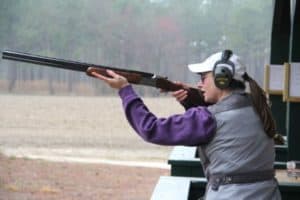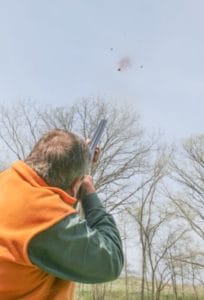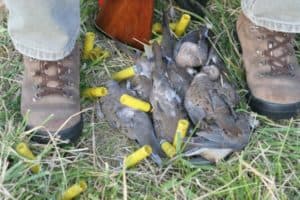by David Hart
How can a flying disk escape a swarm of lead pellets 6 feet long and 3 feet wide?

Proper form is half the battle for effective shotgun shooting. Keep your head down on the stock, focus on the bird, and follow through after you pull the trigger.
It’s a question skeet, trap and sporting clays shooters ask each time they pull the trigger on their shotgun and miss.
The truth is, breaking clay pigeons consistently isn’t easy. Even veteran shotgun shooters miss. The “birds” fly at 40, 50 or even 60 miles per hour, and on some ranges they cross, rise, fall and otherwise travel at odd angles. You can break more, though, by correcting a few common mistakes.
Keep Your Head Down
First, says Dan O’Conner, the general manager and shooting instructor, keep your head down on the shotgun.
Many beginning shooters want to see the clay pigeon shatter before they pull the trigger, so they lift their cheek and look over the gun. That changes the sight picture, which results in a poor aim point.
“That can be corrected by starting with the gun mounted before you throw the bird,” says O’Connor, a shooting instructor for 20 years. “I’ll do that until the shooter keeps his head down on the stock, then I’ll have him start the gun under his arm.”
Focus On Your Target
Accomplished rifle shooters follow the axiom: Aim big, miss big; aim small, miss small. O’Connor says clay-target shooters can break more birds by doing the same. You don’t actually aim with a shotgun, of course, but you do need to focus on the target.
“A lot of people don’t concentrate on the target itself. They look at the general direction of the target,” he says.
More precisely, O’Connor recommends focusing on a particular part of the clay pigeon. Some instructors suggest looking at the leading edge, but O’Connor likes his shooters to focus on the rings of the target itself. Either way, the idea is to focus on a particular part of the clay target, just as hunters should focus on a real bird’s head when they pull the shotgun trigger.
That Clay’s Too Far
Don’t wait too long to pull the trigger. As the shotgun pattern moves downrange, it spreads. The farther it gets, the more holes there are between pellets. That can allow the clay target to escape unbroken.
A good rule of thumb is to shoot before the target gets beyond 30 yards, which is the accepted maximum range for an improved cylinder choke for a standard 12 gauge shotgun.
That’s not necessarily a problem on the skeet range, where clay pigeons are always within range, but it can be an issue on sporting clays and trap ranges. Some shotgun shooters use a tighter choke when they know the targets will be beyond 30 yards.
Follow Through On Your Shot

There’s no better way to break more skeet, trap or sporting clays than by doing it often. Practice may not make you perfect, but you’ll certainly get better.
A good golfer doesn’t stop his swing after he makes contact with the ball, so a shooter shouldn’t stop swinging after he pulls the trigger. Many do, though.
O’Connor says that’s a common mistake, and one that results in a miss behind the bird. Few misses occur from shooting too far in front of the bird.
A good rule is to swing on the target, swing through it, and squeeze the trigger when you see daylight between the target and the muzzle of your shotgun. Of course, the distance and angle of the bird determines lead, but it’s critical to shoot where the target will be when the shot pattern reaches it, not where the bird is at the moment.
“Follow through even when you miss,” says O’Connor. “It’s good for muscle memory.”
It’s also important to understand that breaking clays consistently is just like anything else that requires skill… The more you do it, the better you will get. Shoot often, and you’ll break more clays.
The Union Sportsmen’s Alliance website is designed to provide valuable articles about hunting, fishing and conservation for members of AFL-CIO affiliated labor unions and all sportsmen and sportswomen who appreciate hunting and fishing and want to preserve our outdoor heritage for future generations. If you would like your own story and experience from the outdoors to be considered for our website, please email us at USAmembers@unionsportsmen.org.





